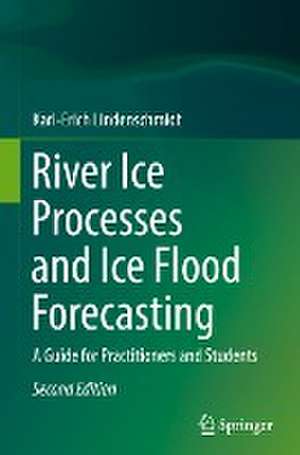River Ice Processes and Ice Flood Forecasting: A Guide for Practitioners and Students
Autor Karl-Erich Lindenschmidten Limba Engleză Hardback – 2 feb 2024
| Toate formatele și edițiile | Preț | Express |
|---|---|---|
| Paperback (1) | 486.98 lei 3-5 săpt. | |
| Springer International Publishing – 5 oct 2020 | 486.98 lei 3-5 săpt. | |
| Hardback (1) | 482.61 lei 38-45 zile | |
| Springer International Publishing – 2 feb 2024 | 482.61 lei 38-45 zile |
Preț: 482.61 lei
Preț vechi: 595.82 lei
-19% Nou
Puncte Express: 724
Preț estimativ în valută:
92.34€ • 96.42$ • 76.43£
92.34€ • 96.42$ • 76.43£
Carte tipărită la comandă
Livrare economică 31 martie-07 aprilie
Preluare comenzi: 021 569.72.76
Specificații
ISBN-13: 9783031490873
ISBN-10: 3031490878
Pagini: 483
Ilustrații: XIX, 483 p. 509 illus., 429 illus. in color.
Dimensiuni: 155 x 235 mm
Greutate: 0.95 kg
Ediția:2nd ed. 2024
Editura: Springer International Publishing
Colecția Springer
Locul publicării:Cham, Switzerland
ISBN-10: 3031490878
Pagini: 483
Ilustrații: XIX, 483 p. 509 illus., 429 illus. in color.
Dimensiuni: 155 x 235 mm
Greutate: 0.95 kg
Ediția:2nd ed. 2024
Editura: Springer International Publishing
Colecția Springer
Locul publicării:Cham, Switzerland
Cuprins
Notă biografică
Karl-Erich Lindenschmidt is a professor at the University of Saskatchewan. He holds a Bachelor of Science in Mechanical Engineering from the University of Manitoba, a Master of Applied Science in Mechanical Engineering from the University of Toronto, a PhD in Environmental Engineering from the Technical University of Berlin and a Habilitation degree from the Technical University of Cottbus, Germany. Before his appointment at the University of Saskatchewan, Karl was with Manitoba Water Stewardship as a hydrologic modelling research engineer where one of his research topics involved monitoring and modelling river ice processes along the Red, Assiniboine and Dauphin Rivers.
His knowledge on river ice processes aided Red River Floodway operations, the Ice Jam Mitigation Program along the lower Red River and flood risk management of the Lake St. Martin/Dauphin River system. He has also extended his portfolio of river ice work and research to include the Slave River in the Northwest Territories, the Peace and Athabasca rivers in Alberta, the Saskatchewan (north and south) and Qu’Appelle rivers in Saskatchewan and the Churchill and Exploits rivers in Newfoundland/Labrador.
His knowledge on river ice processes aided Red River Floodway operations, the Ice Jam Mitigation Program along the lower Red River and flood risk management of the Lake St. Martin/Dauphin River system. He has also extended his portfolio of river ice work and research to include the Slave River in the Northwest Territories, the Peace and Athabasca rivers in Alberta, the Saskatchewan (north and south) and Qu’Appelle rivers in Saskatchewan and the Churchill and Exploits rivers in Newfoundland/Labrador.
Textul de pe ultima copertă
This book exposes practitioners and decision-makers to the theory and application of river ice processes to gain a better understanding of these processes for modelling and ice flood hazard and risk assessment. It focuses on the following processes of the surface water ice: river freeze-up and flooding, mid-winter ice-cover breakup and flooding and end-of-winter ice-cover breakup and ice jamming. The reader will receive a fundamental understanding of the physical processes of each component and how they are applied in monitoring, modelling and flood hazard/risk assessment of river ice during the entire winter season, from freeze-up to potential mid-winter breakup and concluding with springtime ice-cover breakup and ice-jam flooding. Spreadsheet, geographical information system (GIS) and modelling exercises accompany each component to reinforce the theoretical principles learned. Step-by-step tutorial videos allow the reader to better engage with the book and learn the material faster.
Caracteristici
Provides students and practitioners with an understanding of theory and application of river ice processes Includes exercises designed for students to become familiar with available tools such as those used to process Prepares the reader with fundamental knowledge to be applied in monitoring, modelling and forecasting ice covers
